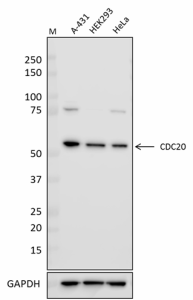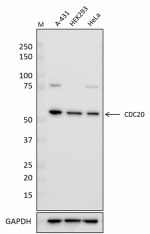- Clone
- W18156A (See other available formats)
- Regulatory Status
- RUO
- Other Names
- Cell Division Cycle 20, Cell Division Cycle Protein 20 Homolog, BA276H19.3, CDC20A, BA276H19.3, p55CDC
- Isotype
- Rat IgG2a, κ
- Ave. Rating
- Submit a Review
- Product Citations
- publications

-

Whole cell extracts (15 µg protein) from the indicated cell lines were resolved on a 4-12% Bis-Tris gel, transferred to PVDF and probed with 0.25 µg/mL (1:2000 dilution) of purified anti-CDC20 antibody (clone W18156A) overnight at 4°C. Proteins were visualized by chemiluminescence detection using HRP Goat anti-rat IgG Antibody (Cat. No. 405405) at a 1:3000 dilution. Direct-Blot™ HRP anti-GAPDH Antibody (Cat. No. 607904) was used as a loading control at a 1:25000 dilution (lower). Lane M: Molecular weight marker. -

Whole cell extracts (250 µg total protein) prepared from HeLa cells were immunoprecipitated overnight with 2.0 µg of Purified Rat IgG2a, κ Isotype Ctrl Antibody (Cat. No. 400502) or purified anti-CDC20 antibody (clone W18156A). The resulting IP fractions and whole cell extract input (6%) were resolved by 4-12% Bis-Tris gel electrophoresis, transferred to a PVDF membrane, and probed with 1.0 µg/mL (1:500 dilution) of purified anti-CDC20 antibody (clone W18156A) overnight at 4°C. Proteins were visualized by chemiluminescence detection using HRP anti-mouse IgG, light chain specific antibody. Lane M: Molecular weight marker.
| Cat # | Size | Price | Save |
|---|---|---|---|
| 934701 | 25 µg | ¥22,220 | |
| 934702 | 100 µg | ¥55,660 |
CDC20 is a co-activator of the anaphase-promoting complex or cyclosome (APC/C) and is a cell cycle regulator that initiates the metaphase-to-anaphase transition. In early mitosis, APC/C is phosphorylated by Cdk1 and CDC20 binds to the APC/C. CDC20 activates the APC/C-mediated ubiquitination of anaphase inhibitors, including securin and cyclin B. Degradation of these proteins results in the activation of separase, which cleaves the Scc1 subunit of cohesion complex to trigger chromosome segregation, and thereby promoting mitotic exit.
Product DetailsProduct Details
- Verified Reactivity
- Human
- Antibody Type
- Monoclonal
- Host Species
- Rat
- Immunogen
- Partial recombinant human CDC20 protein
- Formulation
- Phosphate-buffered solution, pH 7.2, containing 0.09% sodium azide.
- Preparation
- The antibody was purified by affinity chromatography.
- Concentration
- 0.5 mg/mL
- Storage & Handling
- The antibody solution should be stored undiluted between 2°C and 8°C.
- Application
-
WB - Quality tested
IP - Verified - Recommended Usage
-
Each lot of this antibody is quality control tested by Western blotting. For Western blotting, the suggested use of this reagent is 0.1 - 1.0 µg/mL. For immunoprecipitation, the suggested use of this reagent is 2.0 µg/test. It is recommended that the reagent be titrated for optimal performance for each application.
- Application Notes
-
This clone does not recognize mouse CDC20.
This clone recognized a ~75 kD protein of unknown origin by western blot and immunoprecipitation. Because of this, we have not tested or recommend this clone for immunocytochemistry.
Due to the presence of the ~75 kD protein of unknown origin in W18156A immunoprecipitates, we do not recommend the clone to be used for co-immunoprecipitation applications. - RRID
-
AB_2820217 (BioLegend Cat. No. 934701)
AB_2820218 (BioLegend Cat. No. 934702)
Antigen Details
- Structure
- CDC20 is a 499 amino acid protein with a predicted molecular weight of 55 kD.
- Distribution
-
Centrosome/ubiquitously expressed
- Function
- Coactivator/Cell cycle regulator
- Biology Area
- Cell Cycle/DNA Replication
- Antigen References
-
- Visintin R, et al. 1997. Science. 278: 460.
- Fang G, et al. 1998. Mol. Cell. 2:163.
- Shirayama M, et al. 1999. Nature. 402:203.
- Yu H. 2007. Mol. Cell. 27:3.
- Pesin JA and Orr-Weaver TL. 2008. Annu. Rev. Cell. Dev. Biol. 24:475.
- Izawa D and Pines J. 2011. Nat Cell Biol. 13:223
- Gene ID
- 991 View all products for this Gene ID
- UniProt
- View information about CDC20 on UniProt.org
Related FAQs
Other Formats
View All CDC20 Reagents Request Custom Conjugation| Description | Clone | Applications |
|---|---|---|
| Purified anti-CDC20 | W18156A | WB,IP |
Compare Data Across All Formats
This data display is provided for general comparisons between formats.
Your actual data may vary due to variations in samples, target cells, instruments and their settings, staining conditions, and other factors.
If you need assistance with selecting the best format contact our expert technical support team.









Follow Us